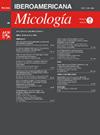Experience with isavuconazole in the treatment of mucormycosis and breakthrough fungal infections
IF 1.6
4区 生物学
Q4 MYCOLOGY
引用次数: 0
Abstract
Isavuconazole, a triazole-class antifungal, is effective and safe for both primary treatment and salvage therapy in a variety of fungal infections. This article reviews recent knowledge on the role of this antifungal in the treatment of mucormycosis and breakthrough invasive fungal infections (bIFI) during antifungal therapy. Isavuconazole has demonstrated favorable clinical outcomes and a good safety profile in various patient populations with mucormycosis, including those with comorbidities such as diabetes mellitus or severe immunosuppression. Particularly noteworthy is the fact that drug interactions in patients with mucormycosis, where a solid organ transplant was a predisposing factor, have been effectively managed. In the treatment of bIFIs, the use of isavuconazole requires a thoughtful reflection about the fungal species involved and their susceptibility profiles. This is highly dependent on the antifungal agent administered before the onset of bIFI. Early diagnosis and appropriate antifungal therapy are essential to improve outcomes in patients with mucormycosis and bIFIs. Isavuconazole represents a valuable option for managing these complex infections.
异戊康唑治疗毛霉病及突破性真菌感染的体会。
Isavuconazole是一种三唑类抗真菌药物,在各种真菌感染的初级治疗和救助治疗中都是有效和安全的。本文综述了该抗真菌药物在治疗毛霉病和突破性侵袭性真菌感染(bIFI)中的作用。Isavuconazole在各种毛霉病患者群体中显示出良好的临床结果和良好的安全性,包括患有糖尿病或严重免疫抑制等合并症的患者。特别值得注意的是,毛霉病患者的药物相互作用已得到有效控制,其中实体器官移植是一个易感因素。在治疗bIFIs时,使用异唑康唑需要对所涉及的真菌种类及其敏感性进行深思熟虑。这高度依赖于bIFI发病前使用的抗真菌药物。早期诊断和适当的抗真菌治疗对于改善毛霉病和bIFIs患者的预后至关重要。Isavuconazole是治疗这些复杂感染的一个有价值的选择。
本文章由计算机程序翻译,如有差异,请以英文原文为准。
求助全文
约1分钟内获得全文
求助全文
来源期刊

Revista Iberoamericana De Micologia
MYCOLOGY-
CiteScore
1.90
自引率
0.00%
发文量
17
审稿时长
81 days
期刊介绍:
Revista Iberoamericana de Micología (Ibero-American Journal of Mycology) is the official journal of the Asociación Española de Micología, Asociación Venezolana de Micología and Asociación Argentina de Micología (The Spanish, Venezuelan, and Argentinian Mycology Associations). The Journal gives priority to publishing articles on studies associated with fungi and their pathogenic action on humans and animals, as well as any scientific studies on any aspect of mycology. The Journal also publishes, in Spanish and in English, original articles, reviews, mycology forums, editorials, special articles, notes, and letters to the editor, that have previously gone through a scientific peer review process.
 求助内容:
求助内容: 应助结果提醒方式:
应助结果提醒方式:


